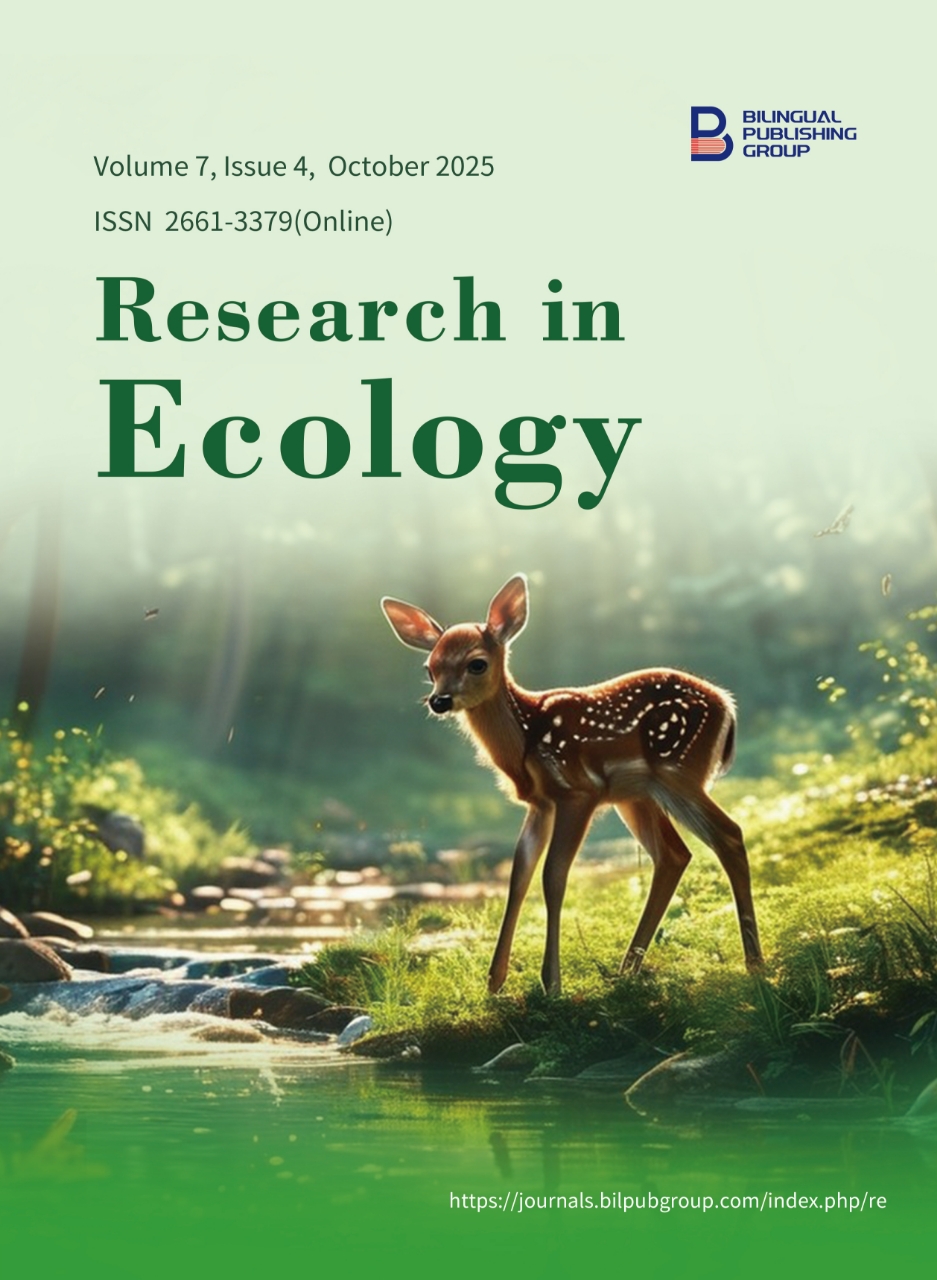
Ecotoxicological Risks in a Brackish Lake Ecosystem During Climate Change Scenarios: A Comprehensive Review on Lake Tudakul
DOI:
https://doi.org/10.30564/re.v7i4.9875Abstract
Climate change and anthropogenic pressures increasingly threaten the ecological integrity of inland water bodies, particularly saline lakes due to their unique hydrological and biological features. This review focuses on Lake Tudakul, one of Uzbekistan’s largest saline lakes and a Ramsar-listed wetland, assessing its vulnerability under future climate scenarios. The study integrates climate scenario modeling (RCP4.5 and RCP8.5) with standardized ecotoxicological bioassays—Microtox®, MARA, algal growth inhibition, Lemna minor, and Daphnia magna toxicity tests—to evaluate combined effects of rising temperatures (2.0 °C and 4.5 °C) and chemical pollutants. Results reveal increased biological sensitivity to contaminants under elevated temperatures, suggesting potential synergistic impacts that may disrupt lake ecosystem structure and function. Lake Tudakul, a regional biodiversity hotspot, is exposed to agrochemical runoff, increasing salinity, and microplastic pollution, threatening aquatic organisms and ecological services. The accumulation and trophic transfer of pollutants—such as heavy metals, persistent organic compounds, and micro(nano)plastics—pose risks to food webs, public health, and water safety. These stressors may also increase the likelihood of harmful algal blooms and cyanotoxin outbreaks. The study emphasizes the urgent need for early-warning systems, adaptive management, and transboundary cooperation to mitigate ecological risks. Lake Tudakul exemplifies the vulnerability of semi-arid lakes under compounding climate and human pressures, highlighting the importance of integrative, ecosystem-based strategies to safeguard biodiversity and freshwater resources.
Keywords:
Lake Tudakul; Climate Change; Ecotoxicology; Central Asia; RCP ScenariosReferences
[1] Jackson, L.J., Lauridsen, T.L., Søndergaard, M., et al., 2007. A comparison of shallow Danish and Canadian lakes and implications for climate change. Freshwater Biology. 52(9), 1782–1792.
[2] Intergovernmental Panel on Climate Change (IPCC), 2014. Climate Change 2013 – The Physical Science Basis. Working Group I Contribution to the Fifth Assessment Report of the Intergovernmental Panel on Climate Change. Cambridge University Press: Cambridge, UK.
[3] Havens, K.E., Paerl, H.W., 2015. Climate change at a crossroad for control of harmful algal blooms. Environmental Science & Technology. 49(21), 12605–12606. DOI: https://doi.org/10.1021/acs.est.5b03990
[4] Jeppesen, E., Meerhoff, M., Davidson, T.A., et al., 2014. Climate change impacts on lakes: An integrated ecological perspective based on a multi-faceted approach, with special focus on shallow lakes. Journal of Limnology. 73, 88–111.
[5] Havens, K., Jeppesen, E., 2018. Ecological Responses of Lakes to Climate Change. Water. 10(7), 917. DOI: https://doi.org/10.3390/w10070917
[6] Kopacek, J., Brahney, J., Kana, J., et al., 2024. The concentration of organic nitrogen in mountain lakes is increasing as a result of reduced acid deposition and climate change. Science of the Total Environment. 950, 175363.
[7] Pastorino, P., Barcelo, D., Prearo, M., 2024. Alps at risk: high-mountain lakes as reservoirs of persistent and emerging contaminants. Journal of Contaminant Hydrology. 264, 104361.
[8] Borgå, K., McKinney, M.A., Routti, H., et al., 2022. The influence of global climate change on accumulation and toxicity of persistent organic pollutants and chemicals of emerging concern in Arctic food webs. Environmental Science: Processes & Impacts. 24(10), 1544–1576.
[9] Kazmi, S.S.U.H., Wang, Y.Y.L., Cai, Y.E., et al., 2022. Temperature effects in single or combined with chemicals to the aquatic organisms: an overview of thermo-chemical stress. Ecological Indicators. 143, 109354.
[10] Grunst, M.L., Grunst, A.S., Gremillet, D., et al., 2023. Combined threats of climate change and contaminant exposure through the lens of bioenergetics. Global Change Biology. 29(18), 5139–5168.
[11] Medina-Sanchez, J.M., Cabrerizo, M.J., Gonzalez-Olalla, J.M., et al., 2022. High mountain lakes as remote sensors of global change. In: Zamora, R., Oliva, M. (eds.). The Landscape of the Sierra Nevada: A Unique Laboratory of Global Processes in Spain. Springer International Publishing: Cham, Switzerland. pp. 261–278.
[12] Tartarotti, B., Sommaruga, R., Saul, N., 2022. Phenotypic and molecular responses of copepods to UV radiation stress in a clear versus a glacially turbid lake. Freshwater Biology. 67(8), 1456–1467.
[13] Khakimova, R., Mullabaev, N., Sobirov, J., et al., 2021. Ecological state of Tudakul reservoir in Uzbekistan and estimation of fish capture in last decades. E3S Web of Conferences. 258, 08029. DOI: https://doi.org/10.1051/e3sconf/202125808029
[14] Khusanov, A., Sabirov, O., Frank, Y., et al., 2025. Microplastic pollution of the Zrafshan river tributary in Samarkand and Navoi regions of the Republic of Uzbekistan. Green Analytical Chemistry. 12, 100200. DOI: https://doi.org/10.1016/j.greeac.2024.100200
[15] Barinova, S., Mamanazarova, K., 2021. Diatom Algae-Indicators of Water Quality in the Lower Zarafshan River, Uzbekistan. Water. 13(3), 358. DOI: https://doi.org/10.3390/w13030358
[16] Van Vuuren, D.P., et al., 2011. The Representative Concentration Pathways: An Overview. Climatic Change. 109(1), 5–31. DOI: https://doi.org/10.1007/s10584-011-0148-z
[17] Ünal, Y., 2023. Global Climate Projections and Climate Change In Türkiye. İklim Değişikliği ve Türkiye İklim Ölçüm Ağı. 29–48. DOI: https://doi.org/10.53478/TUBA.978-625-8352-56-6.ch02
[18] Diffenbaugh, N.S., Giorgi, F., 2012. Climate change hotspots in the CMIP5 global climate model ensemble. Climatic Change. 114(3), 813–822. DOI: https://doi.org/10.1007/s10584-012-0570-x
[19] Fai, P.B., Grant, A., 2010. An assessment of the potential of the microbial assay for risk assessment (MARA) for ecotoxicological testing. Ecotoxicology. 19(8), 1626–1633.
[20] Kuefner, W., Hofmann, A.M., Geist, J., et al., 2021. Algal community change in Mountain Lakes of the Alps reveals effects of climate warming and shifting Treelines. Journal of Phycology. 57(4), 1266–1283.
[21] Yousaf, A., Khalid, N., Aqeel, M., et al., 2021. Nitrogen dynamics in wetland systems and its impact on biodiversity. Nitrogen. 2(2), 196–217.
[22] Small, K., Kopf, R.K., Watts, R.J., et al., 2014. Hypoxia, blackwater and fish kills: experimental lethal oxygen thresholds in juvenile predatory lowland river fishes. PLoS ONE. 9(4), e94524.
[23] Cremona, F., Agasild, H., Haberman, J., et al., 2020. How warming and other stressors affect zooplankton abundance, biomass and community composition in shallow eutrophic lakes. Climate Change. 159(4), 565–580.
[24] Iskın, U., Filiz, N., Cao, Y., et al., 2020. Impact of nutrients, temperatures, and a heat wave on zooplankton community structure: an experimental approach. Water. 12(12), 3416.
[25] Wang, L., Shen, H., Wu, Z., et al., 2020. Warming affects crustacean grazing pressure on phytoplankton by altering the vertical distribution in a stratified lake. Science of the Total Environment. 734, 139195.
[26] Crenier, C., Sanchez-Thirion, K., Bec, A., et al., 2019. Interactive impacts of silver and phosphorus on autotrophic biofilm elemental and biochemical quality for a macroinvertebrate consumer. Frontiers in Microbiology. 10, 732.
[27] Sentenac, H., Loyau, A., Zoccarato, L., et al., 2023. Biofilm community composition is changing in remote mountain lakes with a relative increase in potentially toxigenic algae. Water Research. 245, 120547.
[28] Bonacina, L., Fasano, F., Mezzanotte, V., et al., 2023. Effects of water temperature on freshwater macroinvertebrates: a systematic review. Biological Reviews. 98(1), 191–221.
[29] Peng, K., Dong, R., Qin, B., et al., 2023. Macroinvertebrate response to internal nutrient loading increases in shallow eutrophic lakes. Biology. 12(9), 1247.
[30] Yang, P., Jiang, X., Xie, Z., et al., 2024. Eutrophication is better indicated by functional traits than taxonomic composition of macroinvertebrate assemblages in floodplain lakes. Biodiversity and Conservation. 33(14), 4257–4274.
[31] Perilli, S., Pastorino, P., Bertoli, M., et al., 2020. Changes in midge assemblages (Diptera Chironomidae) in an alpine lake from the Italian Western Alps: the role and importance of fish introduction. Hydrobiologia. 847(11), 2393–2415.
[32] Jutfelt, F., 2020. Metabolic adaptation to warm water in fish. Functional Ecology. 34(6), 1138–1141.
[33] Arrighi, J.M., Lencer, E.S., Jukar, A., et al., 2013. Daily temperature fluctuations unpredictably influence developmental rate and morphology at a critical early larval stage in a frog. BMC Ecology. 13(1), 18.
[34] Bullejos, F.J., Carrillo, P., Argaiz, M.V., et al., 2010. Roles of phosphorus and ultraviolet radiation in the strength of phytoplankton-zooplankton coupling in a Mediterranean high mountain lake. Limnology and Oceanography. 55(6), 2549–2562.
[35] Dur, G., Won, E.J., Han, J., et al., 2021. An individual-based model for evaluating post-exposure effects of UV-B radiation on zooplankton reproduction. Ecological Modelling. 441, 109379.
[36] Gu, H., Li, S., Wang, H., et al., 2022. Interspecific differences and ecological correlations of ultraviolet radiation tolerance in low- and high-altitude fishes. Frontiers in Marine Science. 9, 1035140.
[37] Fernandez, C.E., Campero, M., Bianco, G., et al., 2020. Local adaptation to UV radiation in zooplankton: a behavioral and physiological approach. Ecosphere. 11(4), e03081.
[38] Bandara, K., Varpe, Ø., Wijewardene, L., et al., 2021. Two hundred years of zooplankton vertical migration research. Biological Reviews. 96(4), 1547–1589.
[39] Alton, L.A., Franklin, C.E., 2017. Drivers of amphibian declines: effects of ultraviolet radiation and interactions with other environmental factors. Climate Change Responses. 4(1), 6.
[40] Franco-Belussi, L., Fanali, L.Z., De Oliveira, C., 2018. UV-B affects the immune system and promotes nuclear abnormalities in pigmented and non-pigmented bullfrog tadpoles. Journal of Photochemistry and Photobiology B: Biology. 180, 109–117.
[41] Qiu, Y.W., Zeng, E.Y., Qiu, H., et al., 2017. Bioconcentration of polybrominated diphenyl ethers and organochlorine pesticides in algae is an important contaminant route to higher trophic levels. Science of the Total Environment. 579, 1885–1893.
[42] Miner, K.R., Blais, J., Bogdal, C., et al., 2017. Legacy organochlorine pollutants in glacial watersheds: a review. Environmental Science: Processes & Impacts. 19(12), 1474–1483.
[43] O’Donnell, J.A., Carey, M.P., Koch, J.C., et al., 2024. Metal mobilization from thawing permafrost to aquatic ecosystems is driving rusting of Arctic streams. Communications Earth & Environment. 5(1), 268.
[44] Yun, X., Lewis, A.J., Stevens-King, G., et al., 2023. Bioaccumulation of per- and polyfluoroalkyl substances by freshwater benthic macroinvertebrates: impact of species and sediment organic carbon content. Science of the Total Environment. 866, 161208.
[45] Hossack, B.R., Davenport, J.M., Mattison, C.K., et al., 2025. Methylmercury in subarctic amphibians: environmental gradients, bioaccumulation, and estimated flux. Environmental Toxicology and Chemistry. 44(3), 698–709.
[46] Ho, J.C., Michalak, A.M., 2020. Exploring temperature and precipitation impacts on harmful algal blooms across continental US lakes. Limnology and Oceanography. 65(5), 992–1009.
[47] Reinl, K.L., Brookes, J.D., Carey, C.C., et al., 2021. Cyanobacterial blooms in oligotrophic lakes: shifting the high-nutrient paradigm. Freshwater Biology. 66(9), 1846–1859.
[48] Burgos-Aceves, M.A., Faggio, C., Betancourt-Lozano, M., et al., 2022. Ecotoxicological perspectives of microplastic pollution in amphibians. Journal of Toxicology and Environmental Health, Part B. 25(8), 405–421.
[49] Burgos-Aceves, M.A., Ilizaliturri-Hernández, C.A., Faggio, C., 2024. Fate and transportation of pharmaceutical residues and PPCPs in the aquatic system: physiological effects and hazards. In: Garg, V. K., Pandey, A., Kataria, N., et al. (eds.). Pharmaceuticals in Aquatic Environments. CRC Press: Boca Raton, Florida, USA. pp. 31–52.
[50] Tumwesigye, E., Nnadozie, C.F., Akamagwuna, F.C., et al., 2023. Microplastics as vectors of chemical contaminants and biological agents in freshwater ecosystems: current knowledge status and future perspectives. Environmental Pollution. 330, 121829.
[51] Mez, K., Hanselmann, K., Preisig, H.R., 1998. Environmental conditions in high mountain lakes containing toxic benthic cyanobacteria. Hydrobiologia. 368(1), 1–15.
[52] Daly, G.L., Wania, F., 2005. Organic contaminants in mountains. Environmental Science & Technology. 39(2), 385–398.
Downloads
How to Cite
Issue
Article Type
License
Copyright © 2025 Nasibakhon M. Naraliyeva, Ferah Sayim, Esra Ersoy Omeroglu, Alperen Ertaş, Dilfuza Nurmanova, Nodirbek Sidikjanov, Dilora Nabieva, Tolibjon Madumarov

This is an open access article under the Creative Commons Attribution-NonCommercial 4.0 International (CC BY-NC 4.0) License.




 Nasibakhon M. Naraliyeva
Nasibakhon M. Naraliyeva






